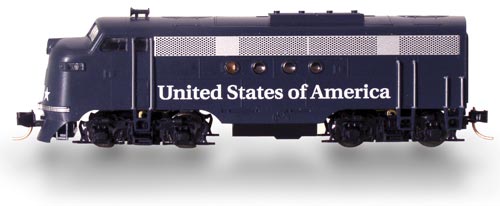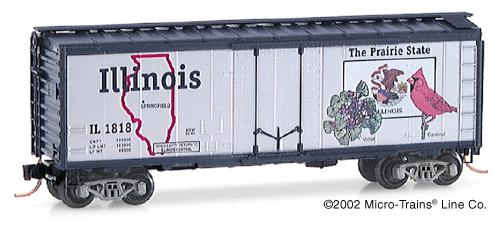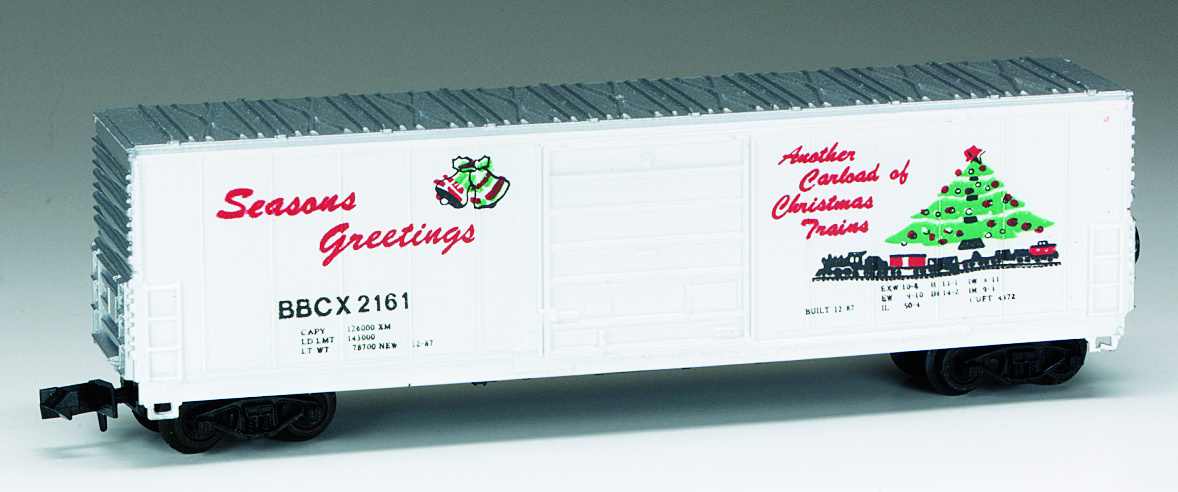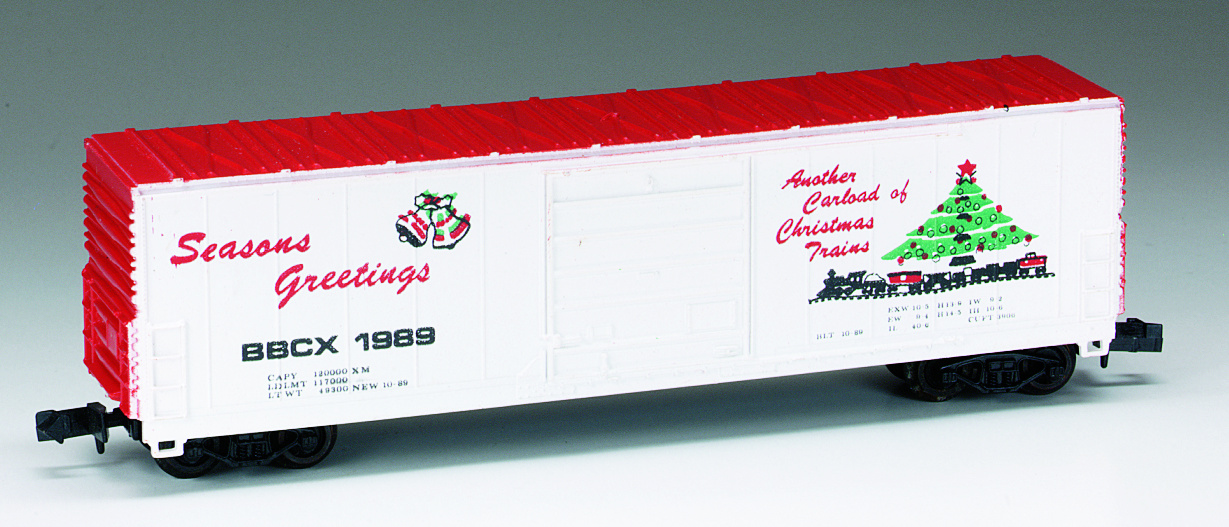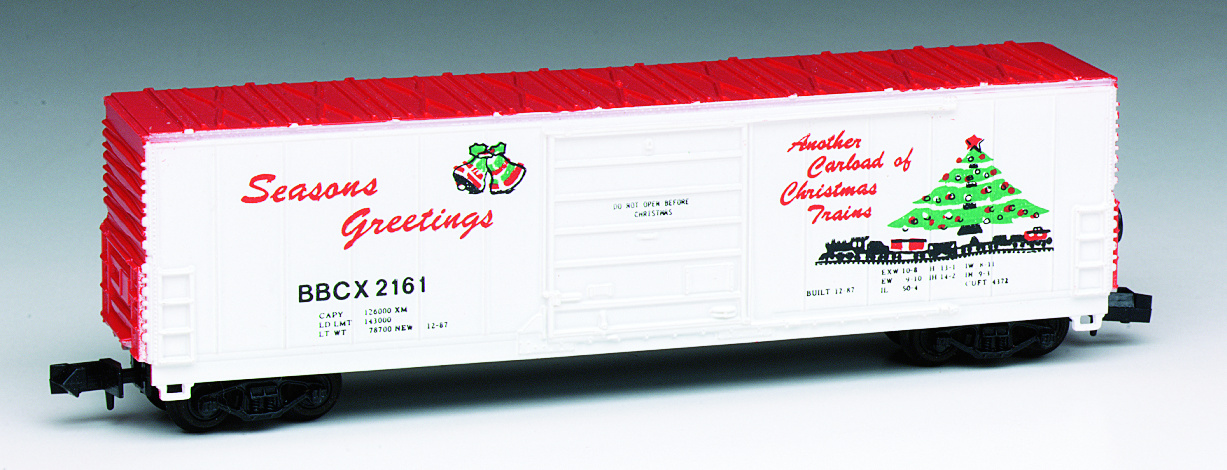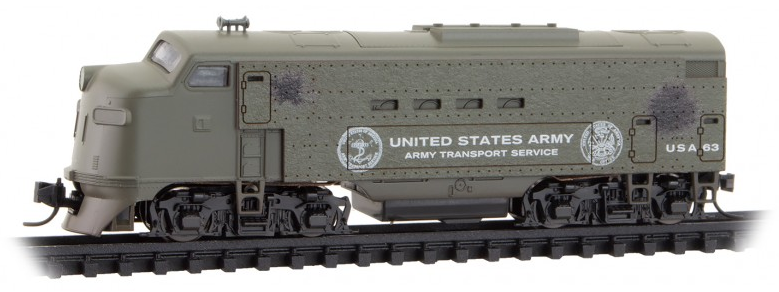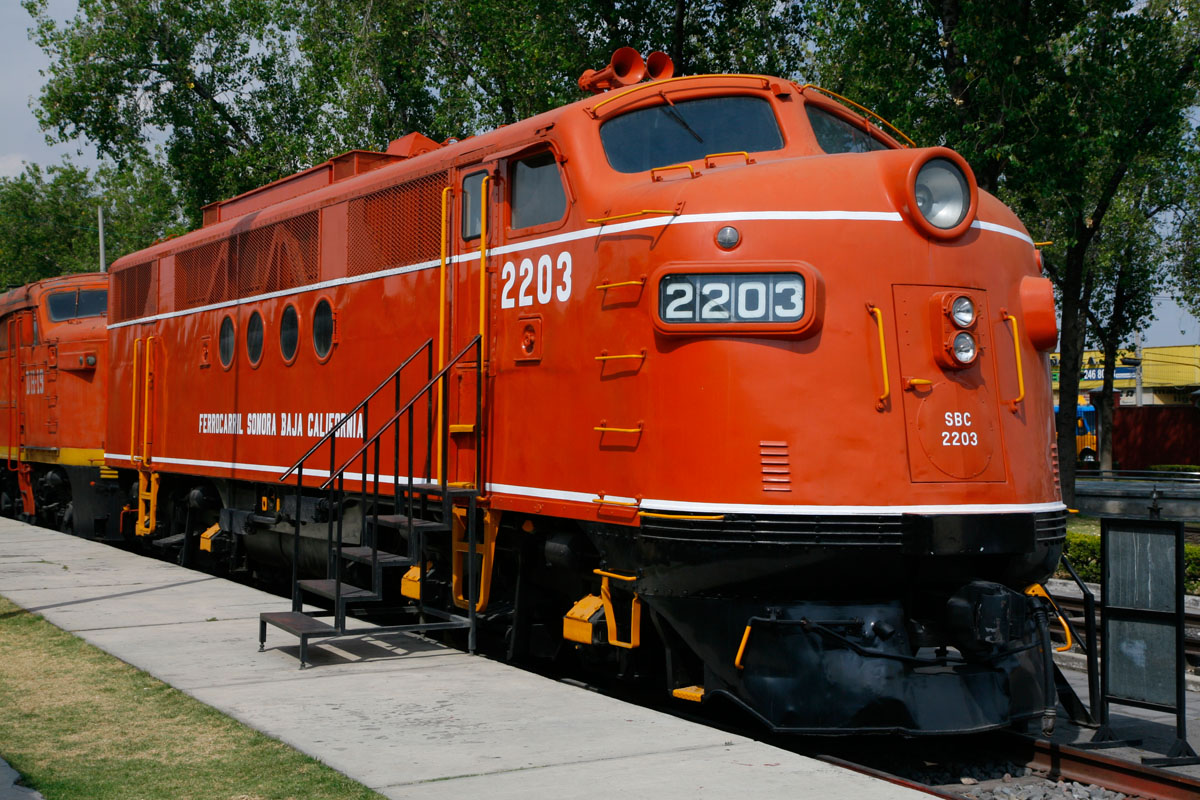Model Information: Prior to 2002 Micro-Trains often released engines made by other manufacturers which they repainted. This model represented a departure from that approach in that MTL contracted Affa Model Train Factory in China to produce the mechanism which MTL then brings back to the United States where they add a US-made and decorated shell. Affa closed in 2018 and Micro-Trains is currently (late Summer 2018) looking for a new manufacturer to produce the mechanisms. However, the tooling for this mechanism may be difficult for MTL to acquire from Affa as is often the case in these situations.
MTL's efforts were hugely successful and their FT release is every bit as good as the Atlas, Kato and Athearn products. It is a "modern" engine with a split-frame, blackened metal wheels, dual flywheels and (of course) Magnematic couplers. They can pull 40 or more cars and they run smoothly and quietly. They really excel at slow speeds in "creep mode".
MTL's efforts were hugely successful and their FT release is every bit as good as the Atlas, Kato and Athearn products. It is a "modern" engine with a split-frame, blackened metal wheels, dual flywheels and (of course) Magnematic couplers. They can pull 40 or more cars and they run smoothly and quietly. They really excel at slow speeds in "creep mode".
DCC Information: Accepts Digitrax DN163M0 decoder: Product Link
Prototype History: The EMD FT was a 1,350-horsepower (1,010 kW) diesel-electric locomotive produced between March 1939 and November 1945, by General Motors' Electro-Motive Division. The "F" stood for 1400 horsepower (rounded from 1350) and the "T" for twin, as it came standard in a two-unit set. The design was developed from the TA model built for the C,RI&P in 1937, and was similar in cylinder count, axle count, length and layout. All told 555 cab-equipped A units were built, along with 541 cabless booster B units, for a grand total of 1,096 units. The locomotives were all sold to customers in the United States. It was the first model in EMD's very successful F-unit series of cab unit freight diesels, and was the locomotive that convinced many U.S. railroads that the diesel-electric freight locomotive was the future. Many rail historians consider the FT one of the most important locomotive models of all time.
The first units produced for a customer were built in December 1940 and January 1941 for the Atchison, Topeka and Santa Fe Railway and numbered the 100 set. These were the first diesel-electric locomotives ever produced with dynamic braking, a system developed at the insistence of the railroad and with its assistance. Initially the four-unit, coupler-equipped set featured two booster units between two cab units in the manner of the demonstrator set. The Brotherhoods of Locomotive Engineers and Firemen, however, insisted that the two cabs required two crews, so the railway had EMD produce extra boosters, and renumbered its earliest sets into four unit sets with one cab unit and three boosters. Negotiation with the unions soon rectified the situation, but as the road's earliest units were geared for higher speeds than subsequent units, these sets continued to be composed of one FTA cab unit and three FTB boosters. This is why the road had ten more FTB booster units than FTA cab units.
From Wikipedia
The first units produced for a customer were built in December 1940 and January 1941 for the Atchison, Topeka and Santa Fe Railway and numbered the 100 set. These were the first diesel-electric locomotives ever produced with dynamic braking, a system developed at the insistence of the railroad and with its assistance. Initially the four-unit, coupler-equipped set featured two booster units between two cab units in the manner of the demonstrator set. The Brotherhoods of Locomotive Engineers and Firemen, however, insisted that the two cabs required two crews, so the railway had EMD produce extra boosters, and renumbered its earliest sets into four unit sets with one cab unit and three boosters. Negotiation with the unions soon rectified the situation, but as the road's earliest units were geared for higher speeds than subsequent units, these sets continued to be composed of one FTA cab unit and three FTB boosters. This is why the road had ten more FTB booster units than FTA cab units.
From Wikipedia
Road Name History: Love it or hate it-- and there's not been all that much middle ground-- the State Car Special Edition series has been, by far, the most ambitious SE program in the entire history of Micro-Trains Line, going all the way back to 1972. Dwarfing the "Bicentennial" series, a mere fourteen releases produced in 1975 and 1976, this collection of rolling stock honored all fifty United States and also included a pair of FT locomotives and a caboose. Additional "member only" cars from the N Scale Collector's Society made by MTL in the same "look and feel" supplemented the main series; we've got those NSC cars included here as well.
Aided by a substantial marketing push in the second half of 2002, the first car in the group, January 2003's Illinois was a very quick sellout and jumped quickly to a high aftermarket premium. The second and third cars, California and New York, also command significant aftermarket values at times, but the Illinois is the key car in the series. Most of the other regular run cars, though becoming a bit harder to find, sell for a large discount to MSRP if you are patient. The NSC cars sometimes sell for more than MSRP but also sometimes not.
The series went through two catalog number changes in its history. Originally, the catalog numbers were by tens as is the practice for most MTL freight car releases. It was probably noted very quickly that the 21000's would have been almost out of numbers by the time that was completed-- the group would have ended at 21810!-- so a switch to single digit increments began with the South Dakota release, 21371. That would have ended the numbering at 21419, except that the eight digit catalog numbers began in January 2005 with West Virginia, 021 00 386.
From July 2008 through September 2012, Z Scale versions of the State Cars were issued. Please refer to the alphabetical listing here to view the release sequence, which was not the same as with the N Scale releases-- other than the Illinois car which opened the Z Scale series in July 2008. The images below are ordered by the sequence of N Scale releases... sorry, but they were done first! The N Scale Collector's Society issued only one "almost a state" cars in Z Scale, the District of Columbia.
Aided by a substantial marketing push in the second half of 2002, the first car in the group, January 2003's Illinois was a very quick sellout and jumped quickly to a high aftermarket premium. The second and third cars, California and New York, also command significant aftermarket values at times, but the Illinois is the key car in the series. Most of the other regular run cars, though becoming a bit harder to find, sell for a large discount to MSRP if you are patient. The NSC cars sometimes sell for more than MSRP but also sometimes not.
The series went through two catalog number changes in its history. Originally, the catalog numbers were by tens as is the practice for most MTL freight car releases. It was probably noted very quickly that the 21000's would have been almost out of numbers by the time that was completed-- the group would have ended at 21810!-- so a switch to single digit increments began with the South Dakota release, 21371. That would have ended the numbering at 21419, except that the eight digit catalog numbers began in January 2005 with West Virginia, 021 00 386.
From July 2008 through September 2012, Z Scale versions of the State Cars were issued. Please refer to the alphabetical listing here to view the release sequence, which was not the same as with the N Scale releases-- other than the Illinois car which opened the Z Scale series in July 2008. The images below are ordered by the sequence of N Scale releases... sorry, but they were done first! The N Scale Collector's Society issued only one "almost a state" cars in Z Scale, the District of Columbia.
Brand/Importer Information: Micro-Trains is the brand name used by both Kadee Quality Products and Micro-Trains Line. For a history of the relationship between the brand and the two companies, please consult our Micro-Trains Collector's Guide.
Manufacturer Information:  Micro-Trains Line split off from Kadee Quality Products in 1990. Kadee Quality Products originally got involved in N-Scale by producing a scaled-down version of their successful HO Magne-Matic knuckle coupler system. This coupler was superior to the ubiquitous 'Rapido' style coupler due to two primary factors: superior realistic appearance and the ability to automatically uncouple when stopped over a magnet embedded in a section of track. The success of these couplers in N-Scale quickly translated to the production of trucks, wheels and in 1972 a release of ready-to-run box cars.
Micro-Trains Line split off from Kadee Quality Products in 1990. Kadee Quality Products originally got involved in N-Scale by producing a scaled-down version of their successful HO Magne-Matic knuckle coupler system. This coupler was superior to the ubiquitous 'Rapido' style coupler due to two primary factors: superior realistic appearance and the ability to automatically uncouple when stopped over a magnet embedded in a section of track. The success of these couplers in N-Scale quickly translated to the production of trucks, wheels and in 1972 a release of ready-to-run box cars.
Micro-Trains Line Co. split off from Kadee in 1990 to form a completely independent company. For this reason, products from this company can appear with labels from both enterprises. Due to the nature of production idiosyncrasies and various random factors, the rolling stock from Micro-Trains can have all sorts of interesting variations in both their packaging as well as the products themselves. When acquiring an MTL product it is very important to understand these important production variations that can greatly enhance (or decrease) the value of your purchase.
Please consult our Micro-Trains Collector's Guide

Micro-Trains Line Co. split off from Kadee in 1990 to form a completely independent company. For this reason, products from this company can appear with labels from both enterprises. Due to the nature of production idiosyncrasies and various random factors, the rolling stock from Micro-Trains can have all sorts of interesting variations in both their packaging as well as the products themselves. When acquiring an MTL product it is very important to understand these important production variations that can greatly enhance (or decrease) the value of your purchase.
Please consult our Micro-Trains Collector's Guide
Item created by: gdm on 2015-07-22 13:47:48. Last edited by gdm on 2020-05-29 13:57:01
If you see errors or missing data in this entry, please feel free to log in and edit it. Anyone with a Gmail account can log in instantly.
If you see errors or missing data in this entry, please feel free to log in and edit it. Anyone with a Gmail account can log in instantly.


